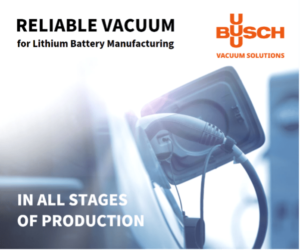Lithium-ion batteries are at the heart of e-mobility and during manufacturing key processes are performed under vacuum. Busch has a selection of vacuum pumps for various requirements

Need vacuum in your lithium battery manufacturing process? Busch Vacuum Solutions can help.
Lithium-ion batteries are at the heart of e-mobility and during manufacturing key processes are performed under vacuum. Busch has a selection of vacuum pumps for various requirements
This article is Sponsored Content presented by Busch Vacuum Solutions
Lithium (Li) is the lightest solid element and its electrically charged ions move easily. Li-ion batteries power everything from smartphones and tablets to electric cars. These batteries store significant charge per unit of mass and that makes them one of the most promising energy sources for zero-emission vehicles. Ensuring the effective production of these batteries, Busch vacuum solutions are in operation at major lithium-ion battery production sites around the world.
Thinner than a hair
The electrodes of a Li-ion storage battery consist of extremely thin foils.
In batteries, lithium is used as an anode; rechargeable batteries use lithium metallic oxide as a cathode. The oxide is mixed with a binding agent and other additional materials into a homogeneous paste (slurry).
The slurry is evenly applied to aluminum foil in the coating machine (this process is similar to printing with an inkjet printer). Aluminum is the substrate and serves as a conductor that absorbs the charging current and then emits the stored electricity again.
After the coating process, a roller system conveys the foil while simultaneously pressing it flat until the individual sheets become thinner than a hair. The thicker the coating and the thinner the electrode foil, the more capacity the battery has.
Busch identifies the ideal solution for the various vacuum technology requirements that each individual application needs to meet. Busch has a wide range of different vacuum technologies perfectly suited for all vacuum-assisted stages of lithium-ion battery production. Our products are renowned for their reliability in all stages of the lithium-ion battery production, such as:
Slurry mixing
The initial mixing process of the slurry with lithium metal oxides, binding agents and solvents takes place under vacuum. This prevents air bubbles from getting into the process and ensures a pure, homogenous paste. The result: improved cell capacity.
Slurry drying
A vacuum is used in the drying process to gently remove moisture and other solvents. Vacuum drying can be performed in batches (single chamber) or in-line (multi-chamber system, typically seven to nine chambers).
Electrolyte filling
Ions move between the electrodes using a conductive material: electrolytes. The battery cell is evacuated with the help of a vacuum to ensure that there is no remaining moisture or air. Electrolyte filling also takes place under vacuum for even distribution of the electrolyte within the cell.
Impregnating of the lithium-ion battery cell
The contact between the electrode and electrolyte is essential for the function and efficiency of the battery cell. A vacuum assists this process to ensure that contact is without voids.
Degassing of the electrolyte
The electrolyte is degassed under vacuum to eliminate air bubbles. Thus, lithium-ions are able to move freely enabling efficient charging and discharging of the battery.
Lots of major lithium-ion battery production sites worldwide already rely on Busch. Our range of rotary vane and dry screw vacuum pumps is perfectly suited to meet the needs of small pilot and R&D applications. For large production facilities, we offer tailor-made systems with vacuum pumps and systems, backed by our global service network, that support your production every step of the way.
We also service all-brands of vacuum pumps with our Repair-Rebuild-Replace service at our three Canadian locations in Montréal, Toronto and Vancouver.
Busch Service Hotline: +1 800 363 6360 | busch.ca | [email protected]






